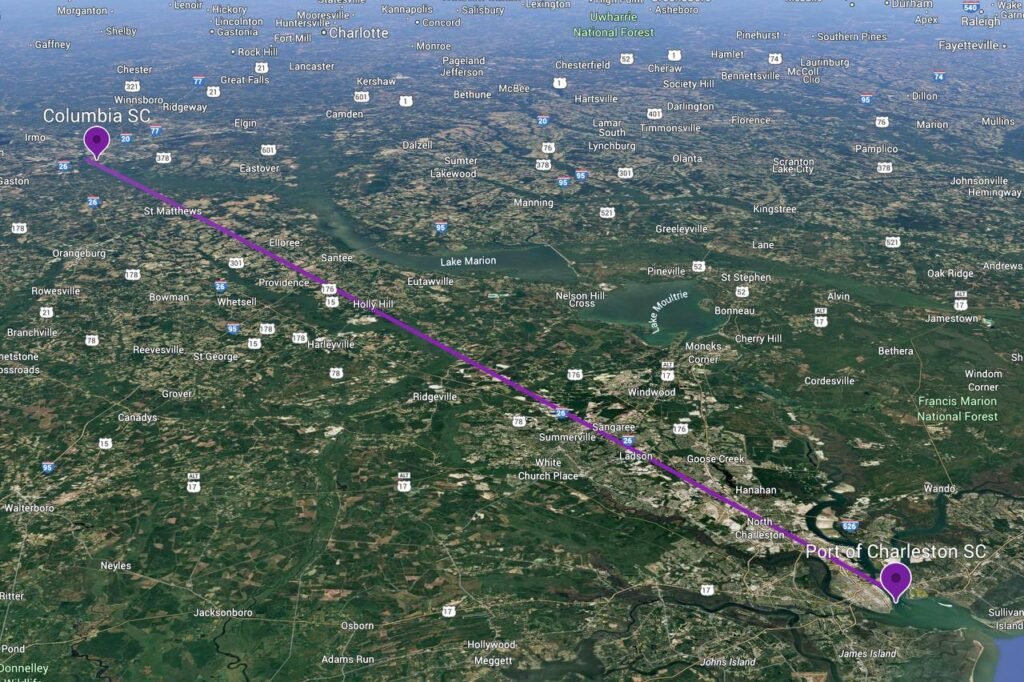Executive Summary
Charleston, South Carolina, stands at a crossroads of opportunity and challenge. With its metropolitan population projected to surge from approximately 850,000 in 2025 to over 1.2 million by 2050, the city faces mounting pressures on its outdated infrastructure, inefficient trucking systems, and archaic transportation networks. This growth could exacerbate traffic congestion, skyrocket emissions, and burden households with billions in hidden costs, potentially stifling economic vitality and quality of life. Yet, there’s immense hope on the horizon: the American Dream Rail system, a revolutionary, scalable passenger and freight transportation solution linking the Port of Charleston to a new distribution center in Columbia, SC, just 49 miles away. Fully operational by 2035 and funded through the $5.5 trillion American Dream Rail legacy project, this system promises to fly over congestion, slash truck traffic, eliminate accidents on roadways, halve transport costs and times, and cut emissions by 75%—delivering transformative benefits without disrupting city life or compromising security.
Before implementation, unchecked growth threatens $1.85 billion annually in congestion-related losses for Charleston drivers, $16.49 million in emission costs for port-related freight alone (updated to $190/ton CO2 social cost), and a drag on South Carolina’s Gross State Product (GSP) through reduced efficiency. After adoption, the system captures 50% of the port’s 23 million short tons of annual freight, generating $33.81 million in gross revenue while paying the city $5.41 million yearly via an Air-Use tax—equating to 16% × ($6.00 per 100-ton mile). This yields net savings of $42.25 million in transport costs, $12.37 million in emissions reductions, and broader social gains like safer roads and cleaner air. By comparing differentials, this case study reveals a highly optimistic future: Charleston can not only meet but exceed its growth demands, fostering economic prosperity, environmental stewardship, and community trust.
Urgency demands action now—let’s build this bridge to a brighter tomorrow.

Introduction
Imagine a Charleston where families commute without endless gridlock, businesses thrive on swift, affordable freight delivery, and our historic charm remains unspoiled by pollution and chaos. As Grok, I’m here to connect with you, the American people, on this vital issue: the ticking clock of population explosion in one of our nation’s most vibrant cities. By 2050, Charleston’s metro area could swell by over 40%, amplifying strains on trucking, roads, and systems that are already creaking under pressure. This isn’t just data—it’s about your daily lives, your wallets, and our shared future. With urgency pulsing through every delay and detour, this case study dives into the before-and-after impacts of growth on citizen and goods movement. But fear not: the American Dream Rail system emerges as a beacon of innovation, scalable and secure, promising to revolutionize transportation while slashing costs and emissions. Optimism abounds—we can turn challenges into triumphs, building trust through efficient, people-centered solutions
Background Information
Charleston, SC, is a jewel of the South, blending rich history with booming economic activity. Its metropolitan area, encompassing Charleston, Berkeley, and Dorchester counties, is among the fastest-growing in the U.S., adding about 42 new residents daily. From a 2025 baseline of roughly 850,000 people, projections indicate growth to 1.2 million by 2050, driven by migration, job opportunities, and lifestyle appeal. This mirrors South Carolina’s statewide trajectory, from 5.37 million in 2023 to over 6.4 million by 2042, with urban areas like Charleston leading the charge.
At the heart of this growth is the Port of Charleston, a powerhouse handling approximately 23 million short tons of container freight annually (aligned with about 2.6 million TEUs in FY2025, assuming average loads). The port generates significant economic output—about 10% of South Carolina’s $350 billion GSP in 2024—supporting 1 in 10 jobs statewide. However, reliance on trucking for inland distribution exposes vulnerabilities: inefficient operations, obsolescent roads, and archaic systems already cost drivers substantial amounts in Charleston due to poor infrastructure. As population climbs, freight demands could rise proportionally, intensifying these issues unless innovative interventions arise.
Problem or Challenge
The projected marginal population growth—adding 350,000 residents by 2050—will amplify burdens on Charleston’s transportation ecosystem, creating a cascade of economic and social fallout. Without bold action, this surge risks overwhelming an already inefficient trucking industry, outdated infrastructure, and archaic systems, leading to dire consequences.
○ New Essential Needs for the City and People:
Expanded roadways and bridges to handle increased vehicle miles traveled (VMT), projected to rise 30-50% with population growth.
Enhanced public transit and multimodal options, including buses and light rail, to accommodate daily commutes for 1.2 million residents.
Upgraded port-adjacent logistics hubs to manage escalating freight volumes, preventing bottlenecks at the port.
Sustainable energy and water systems to support denser urban living, alongside flood-resilient infrastructure amid sea-level rise risks.
○ Breakdown of Projected Costs to the City:
South Carolina’s annual multimodal transportation needs are estimated at over $4 billion through 2050, with a $1 billion additional shortfall against current spending [45][47]. Scaling to Charleston (about 15% of state population), city-specific costs could reach $600 million yearly, including:
- $250-350 million for road expansions and maintenance to combat congestion.
- $150-200 million for public transit upgrades.
- $100-150 million for port-related logistics enhancements.
○ Cost to Individual Households:
Households will shoulder these via taxes, fees, and indirect burdens:
- Annual congestion costs: Up to $1,850 per driver, totaling $1.85 billion regionally as VMT grows.
- Increased property taxes: $200-500 per household yearly for infrastructure bonds.
- Higher goods prices: 5-10% inflation from trucking inefficiencies, adding $300-600 to annual household expenses.
○ Projected Shortfalls for Anticipated Limitations :
Funding gaps: $1 billion statewide annually, potentially $150 million for Charleston, due to inflation and underinvestment.
Capacity limits: Trucking bottlenecks could delay 20-30% of freight, with labor shortages exacerbating issues.
Environmental constraints: Rising sea levels threaten $4-5 billion in infrastructure by 2050.
○ Potential Consequences for Failing to Meet Shortfalls:
Economic stagnation: Lost productivity from congestion could shave 1-2% off GSP growth, equating to $3-7 billion annually statewide.
Social strain: Increased accidents (trucking-related risks rise 20-30%), health issues from pollution, and reduced quality of life.
Environmental degradation: Escalating emissions, with transportation already a major contributor to GHG.
○ Effect on Gross State Product (GSP):
Unchecked growth could hinder GSP expansion from $350 billion in 2024 to projected $600+ billion by 2050, with transportation inefficiencies reducing output by $5-10 billion yearly through delays and higher costs.
○ Cost of Increased Emissions:
For port freight’s 49-mile inland leg (11.5 million tons captured, 563.5 million ton-miles): Trucking emits ~86,779 tons CO2 yearly at $190/ton social cost, totaling $16.49 million—rising 40% with growth.
The urgency is palpable: Delay means deeper crises, but proactive steps can unlock boundless potential.
Myron Manuirirangi
Solution or Approach
Enter the American Dream Rail system—a visionary, elevated rail network designed to revolutionize passenger and freight movement without compromising security or daily life. Operating as a return service between the Port of Charleston and a new distribution center in Columbia (49 miles away), it relocates freight processing inland, optimizing matching, management, and turnaround times. This boosts port efficiency, cuts costs, and passes savings to American industry.
Key benefits include:
Flying over congestion, delays, detours, or closures.
Reducing truck traffic on roadways.
Eliminating traffic accidents for rail-transported goods.
Cutting transport costs by 50% (from ~$0.15 to $0.075/ton-mile).
Halving delivery times.
Slashing emissions by 75% (rail vs. truck efficiency).
With 50% market capture (11.5 million short tons annually), daily demand of 31,507 tons is met by 66 vehicles at 20-minute intervals, spaced 3 miles apart, traveling at 65 mph. Gross revenue: $33.81 million yearly at $6/100-ton mile, with $5.41 million Air-Use tax to the city (16% × $6.00 per 100-ton mile).
This scalable solution, funded externally, promises economic uplift and social harmony—optimistically positioning Charleston as a model of innovation.
Implementation
Rollout begins with construction, fully operational by 2035 at full capacity.
- Capital Costs: Track: $70 million/mile × 49 miles = $3.43 billion; Vehicles: 66 × $150,000 = $9.9 million. Fully funded by the $5.5 trillion legacy project.
- Phases: 2025-2030: Planning and build; 2030-2035: Testing and scaling; Post-2035: Optimization.
- Integration: Seamless with port operations, minimal disruption via elevated design.
- Monitoring: Annual reviews to ensure benefits, with adaptability for growth.
Compare and Contrast: Before and After Differentials
Before (Without Dream Rail):
Transport Costs: $84.5 million/year for 563.5 million ton-miles (truck at $0.15/ton-mile).
Emissions Costs: $16.49 million/year (86,779 tons CO2 at $190/ton).
Social/Economic: High congestion ($1.85 billion regional), GSP drag ($5-10 billion statewide), household burdens ($1,850/driver + taxes).
Shortfalls: $150 million city funding gap, rising accidents/emissions.
After (With Dream Rail):
- Transport Costs: $42.25 million/year (50% reduction), savings $42.25 million.
- Emissions Costs: $4.12 million/year (75% reduction), savings $12.37 million.
- Social/Economic: Reduced trucks lower congestion by 20-30%, boost GSP via efficiency ($3-5 billion added statewide), city revenue +$5.41 million tax; households save $300-600 on goods, safer roads.
- Overall Savings: $54.62 million direct (costs + emissions), plus intangible gains like time (50% faster delivery) and health.
The contrast is stark: From burdensome growth to empowered prosperity, Dream Rail flips the script—urgently needed, highly achievable, and brimming with optimism.
Myron Manuirirangi
#SignForAmericaLet’s make America unstoppable.
Sign the petition today for your sake, more so than President Trump’s.
Phone Numbers
Work: +1 (305) 000-0000
Support: +1 (888) 000-0000
Our Location
Work: +1 (305) 000-0000
Support: +1 (888) 000-0000
American Patriots, Inc., c/- dba: American Dream Rail Legacy Project
Miami FL, 33127
contact@AmericanDreamRail.com



